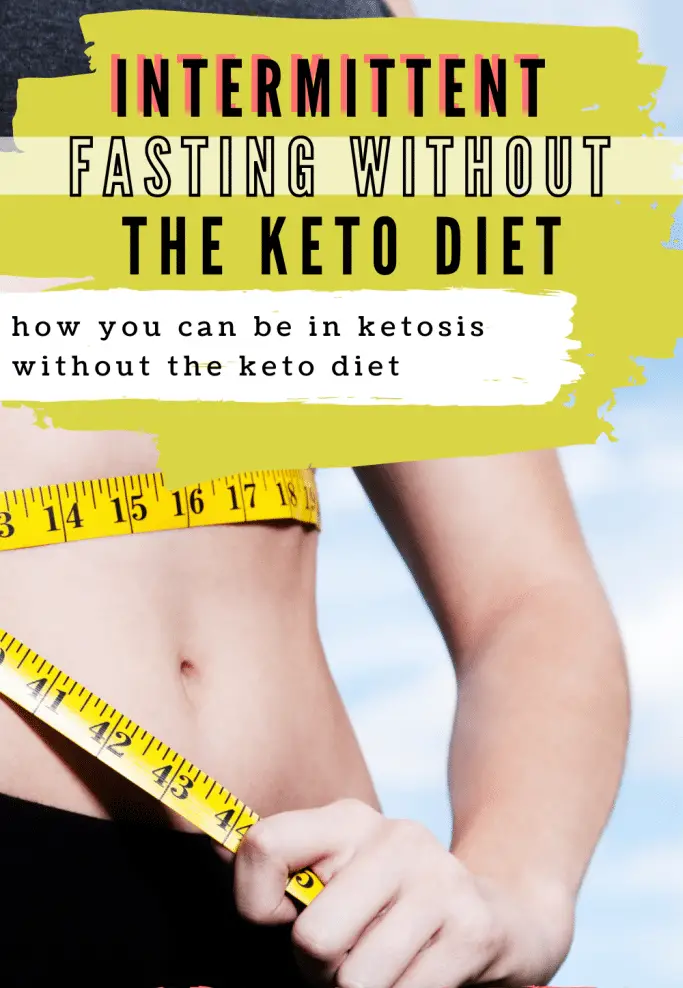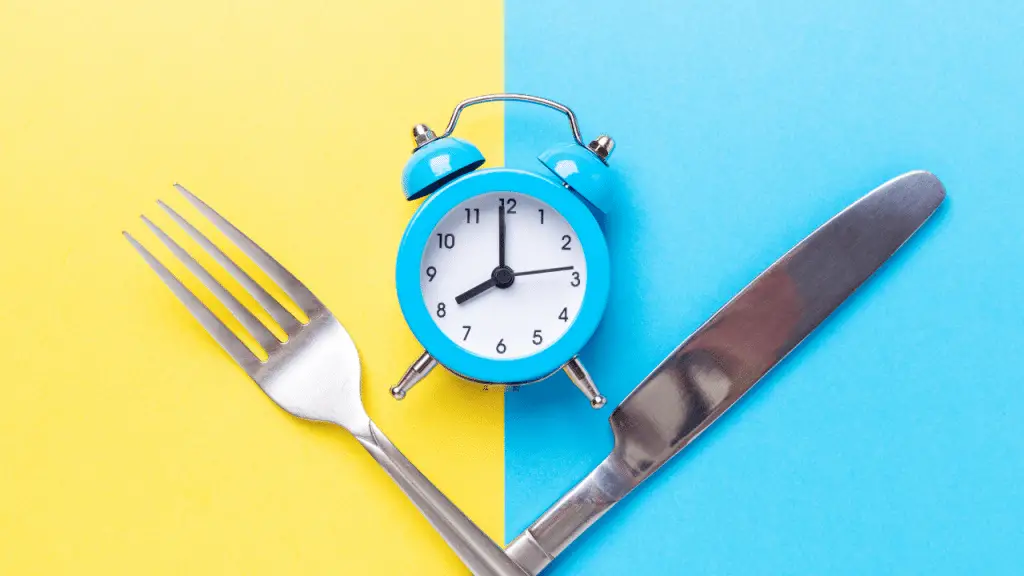Intermittent fasting without keto is a perfect health and weight loss option to train your body to use ketones for energy without counting carbs.
Both intermittent fasting and the keto diet work for weight loss because they help take willpower out of the equation. They are more sustainable than calorie restriction long-term as ketosis naturally decreases your appetite and helps you conquer food cravings. Let’s take a look at how this works.
Intermittent Fasting Without Keto for Weight Loss
First, it’s important to understand how the keto diet and intermittent fasting work for weight loss.

How Does the Keto Diet Work?
The keto diet is a very low-carb, high-fat, and moderate-protein diet. Of your total macronutrient intake, 5% will be carbs, 20% protein, and 75% fat.
If you wonder what 20 g of carbs looks like, let me give you some examples:
- 3 pounds of spinach
- 400 grams of raspberries or blackberries
- 150 grams of blueberries
- 1 1/2 cups of pecans
- a plate of spinach, zucchini, tomatoes, and peppers

On the keto diet, you consume so few carbs that your body runs out of glycogen and uses stored fat to produce ketones for fuel. When your body uses ketones for energy, you are in ketosis.
How Ketosis Helps You Lose Weight
Can you lose weight intermittent fasting without keto? Yes! You can! That’s how I lost 30 pounds after 40! When you are in ketosis, your appetite decreases, and your body burns fat. Naturally, you eat less. Moreover, ketone production decreases inflammation in your body, which also helps you lose stubborn weight. Conversely, continuous calorie restriction makes you feel hungrier and hungrier, and that’s hard to sustain long term.
Intermittent Fasting and Ketosis
How does intermittent fasting without keto work? Your body runs out of glycogen and starts using fat for fuel on the keto diet, but this also happens when you are practicing intermittent fasting (learn How to Start Intermittent Fasting in 5 Simple Steps). After a 12-hour fast, your glycogen reserves are getting low. Exactly how long your body will take to release ketones depends on many factors, including whether you have been in ketosis before.
With experience, you can feel when you are in ketosis. For me, it takes around 18 hours each day. You will need to experiment to find how long YOU need to fast (keep reading, I will show you how).

Intermittent Fasting Vs. Keto
The ketogenic diet mimics fasting by helping your body run out of glycogen without avoiding food. For those getting started, doing the keto diet is a great way to kickstart ketosis fast. Intermittent fasting will be a lot easier once you have been in ketosis. Then, you will benefit from intermittent fasting without keto with more ease.

Why Intermittent Fasting Without Keto May Be Best for You
Is intermittent fasting better than keto? Not really. Or it depends who you ask. They produce a smililar reaction in your body as your body runs out of glycogen and prodocues ketones as a source of energy.
Intermittent fasting for longer periods will allow your body to reap the benefits of switching to fat-burning mode while still consuming carbs which really makes it more sustainable for the average person. Futhermore, women tend to need more carbs than me to ensure proper hormonal function.
I love the food freedom that comes from this approach. Meanwhile, I do support using some keto cycles (between 7-14 days) to help your body switch to a deeper ketosis occasionally. Does keto cycles may be helpful if you notice that you struggle with intense food cravings.
Don’t forget to watch my Intermittent Fasting 101 Workshop for further help and guidance.

Carbs and Hormone Function
Low-carb and ketogenic diets have been shown to help with weight loss and metabolic health. However, carbs support hormone function, and the stress caused by the lack of glycogen may cause hormonal disruptions. Women may even experience amenorrhea. This type of amenorrhea is called functional hypothalamic amenorrhea. It is most commonly caused by too few calories, carbs, weight loss, stress, or too much exercise.
Leptin
Leptin is another hormone that may be affected by a diet too low in calories or carbs. Leptin is produced by your fat cells, and it helps you feel full. Moreover, it contributes to regulating women’s reproductive hormones. Low-carb diets reduce leptin production (but improve leptin sensitivity).
Cortisol
Fasting and a keto diet increase cortisol levels. Cortisol has many benefits, including reduced inflammation and fat loss. However, too much of a good thing can become a bad thing. Too much cortisol can have the opposite effect and cause fat storage and lower estrogen production.
Thyroid Function
T3, the active thyroid hormone, is sensitive to calorie and carb consumption.

Fasting and Hormone Function
The studies that show a connection between poor hormonal health and low-carb or ketogenic diets also relate to calorie restriction. Too few calories (or fasting) could have the same effect. Read How Intermittent Fasting Affects Women’s Hormones for more info.
How to Include Carbs in Your Diet
Now, if you decide to follow a diet that includes more carbs than the keto diet, you might want to try moderate carbs (between 100 g-150 g). Most women will thrive within that range. Some do very well on a high-carb diet (anything above 225 g), but many will find that they feel hungrier when consuming too many carbs.
Here are good examples of carbs that will support your health:
- All veggies and fruits
- Legumes
- Nuts and seeds
- Whole grains (in moderation)
- Tubers (potatoes, Jerusalem artichokes, jicama, and yams)

Why Intermittent Fasting Without Keto Works
As I mentioned, what separates a keto diet and intermittent fasting from calorie restriction for weight loss is that your body is producing ketones. Using ketones for fuel has many benefits beyond weight loss. Here are some benefits you will achieve when practicing intermittent fasting even if you don’t follow a keto diet:
- Better mental focus
- More energy
- Better mood
- Less appetite
- Better sleep
As you become more experienced with intermittent fasting, you will be able to notice these changes. Intermittent fasting without the keto diet works because your body runs out of glycogen and starts producing ketones when you fast.

Intermittent Fasting Vs. Low-Calorie Diet
Low-calorie diets help achieve similar benefits (not from ketone production, but lower insulin levels). They will even allow your body to repair itself through autophagy. However, the problem with low-calorie diets is that they are hard to sustain long-term. Reducing your calorie intake by 20% makes you feel deprived and hungry.
I do recommend short-term calorie deprivation to mimic the effect of prolonged fasting. This calorie deprivation is more severe as it allows you to consume only 40-50 % of your normal calorie intake. It’s called the fasting-mimicking diet, and it has many health benefits. I also achieved ketosis without the keto diet (read my Fasting Mimicking Diet Results).

Can You Lose Weight Without a Calorie Deficit?
When people talk about intermittent fasting, they often mention that you don’t have to count calories. That’s true! However, that’s not to say that you don’t need a calorie deficit to lose weight. What most likely happens is that intermittent fasting creates a calorie deficit as your appetite decreases. It may also be that you are decreasing inflammation, which also helps losing weight. If you want to lose weight using intermittent fasting, read Top 5 Reasons Why You Are Not Losing Weight Using Intermittent Fasting.
Can You Do Keto Part-Time?
You may wonder if it would be worthwhile to do keto part-time. My answer is: of course! Doing the keto diet part-time would be a great way to get into ketosis faster and make intermittent fasting easier.

Intermittent Fasting Without Keto Schedule
Alright, you want to do intermittent fasting without the keto diet. Now what?
Ketosis With Intermittent Fasting Step-by-Step
You will need to think of the right schedule for your lifestyle and experiment to see what works best for you.

Kickstart Ketosis
If you are starting intermittent fasting, I suggest you start with the fasting-mimicking or the keto diet. If you choose the keto diet, you may only need a few days. You will most likely get the keto flu, and when you feel better, you will be in ketosis.
If you choose the fasting-mimicking diet, you may not notice a difference the first time around. Keep experimenting with intermittent fasting for the rest of the month, and you will notice that it will be much easier when you do the fasting-mimicking diet again (after a month). You will achieve ketosis.
Choose Your Intermittent Fasting Schedule
Most people take more than 16 hours to get into optimal weight loss ketosis using intermittent fasting (around 1.0 mmol/L on a ketone monitor). Testing could be helpful. I use this ketone monitor (this is an affiliate link that will give you 15% off your purchase):

You are in ketosis when your reading is above 0.5 mmol/L. With time, you will know the difference without even measuring.
Start gradually, fast from 8 pm to noon the next day for 2-3 weeks, and see if you notice a difference. If you don’t, increase your fasting window (8 pm to 4 pm the next day works best for me) or try a different intermittent fasting method that doesn’t require daily fasting, like the Eat-Stop-Eat Diet.

My Fasting Without Keto Success Story
My story started years ago when I started experimenting with intermittent fasting and other weight loss plans. The first intermittent fasting method I tried was the 16:8 method. I didn’t realize there were other methods! I gave up when I didn’t see the results I was hoping for.
Then, I discovered the fasting-mimicking diet. The fasting-mimicking diet intrigued me mostly for its health and longevity benefits (read 5 Steps to Fasting for Health and Longevity if that also interests you).
However, I was excited to discover that even though I regained the few pounds I had lost initially, the weight started melting off during the rest of the month. I also lost belly fat and did not return even though I ate as much as I wanted.
That’s when I decided to learn about intermittent fasting again. I experimented with a mixture of intermittent fasting methods for about 3-4 months while doing the fasting-mimicking diet once a month. I lost 12 lbs! That was a miracle for me!
Intermittent Fasting Without Keto Video
In Summary
If you want true food freedom, intermittent fasting is an excellent option, and it works! It works because you will get your body into ketosis and decrease your appetite. It will not only help you achieve your weight loss goal, but you will notice that you will have more energy and a better focus. Everyone is unique; what worked for me may not work for you. You will need to keep experimenting to see what works for you. Don’t give up and realize that intermittent fasting is a lifestyle.






